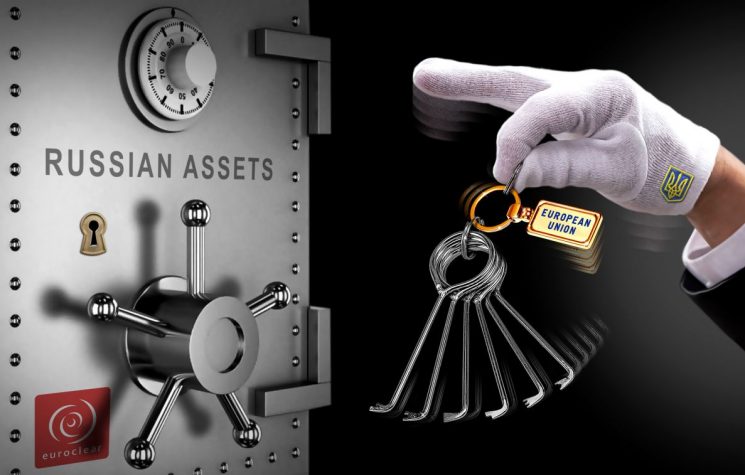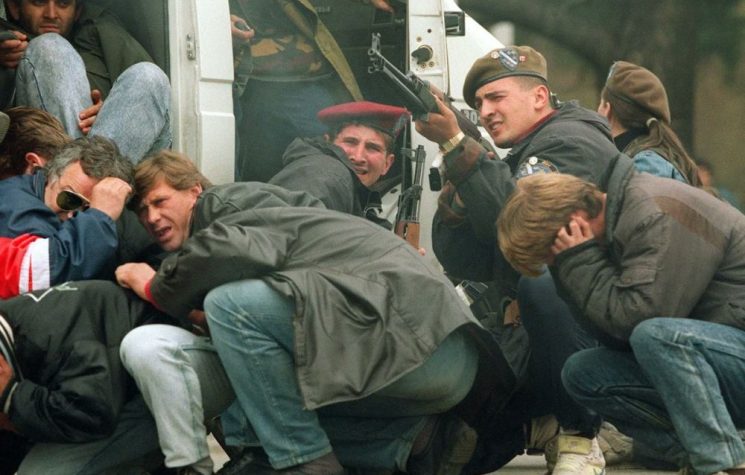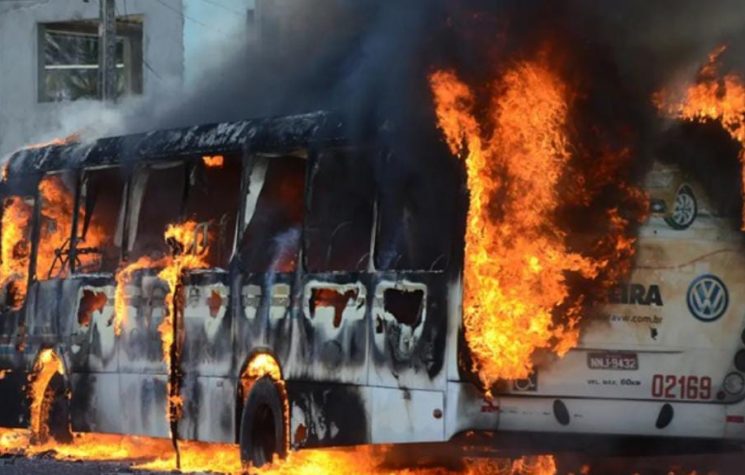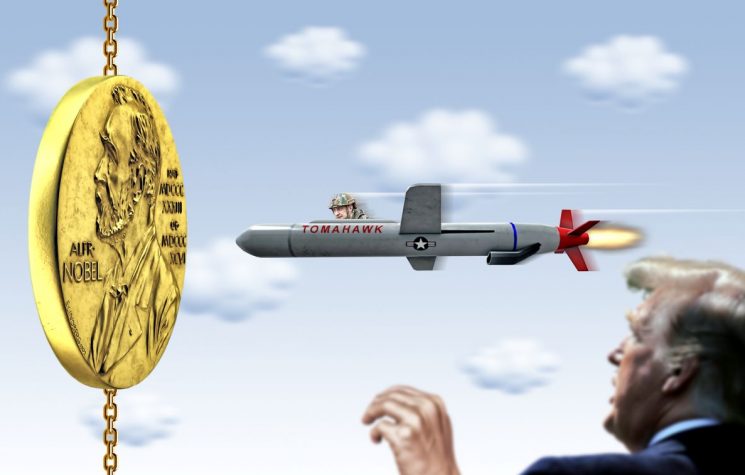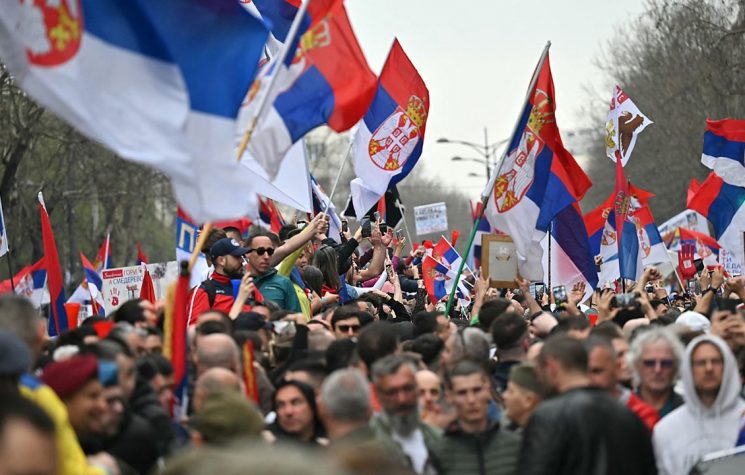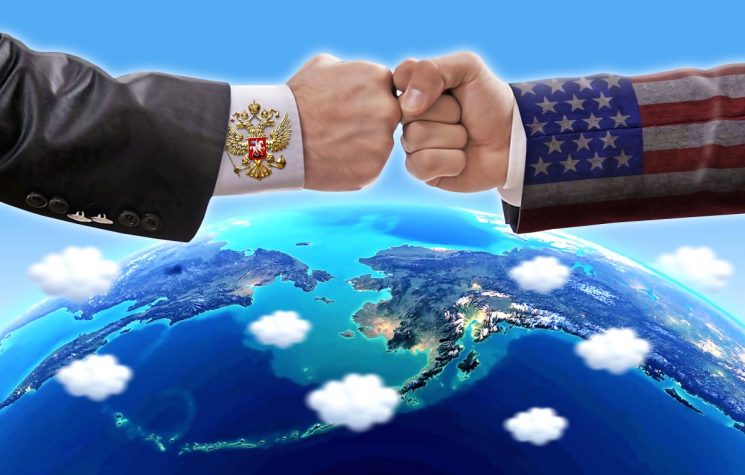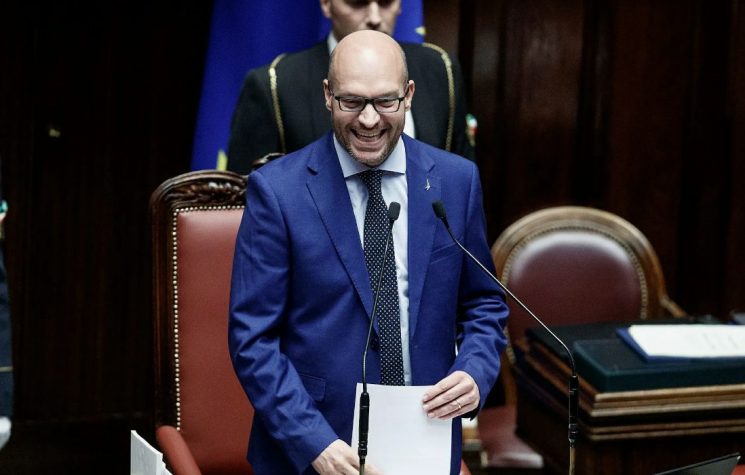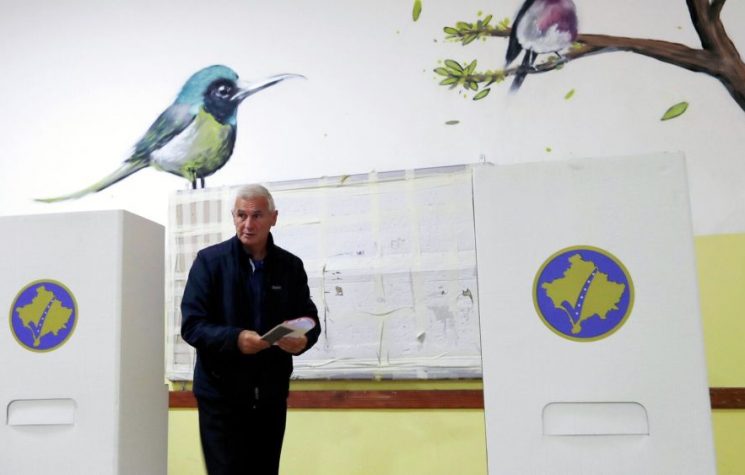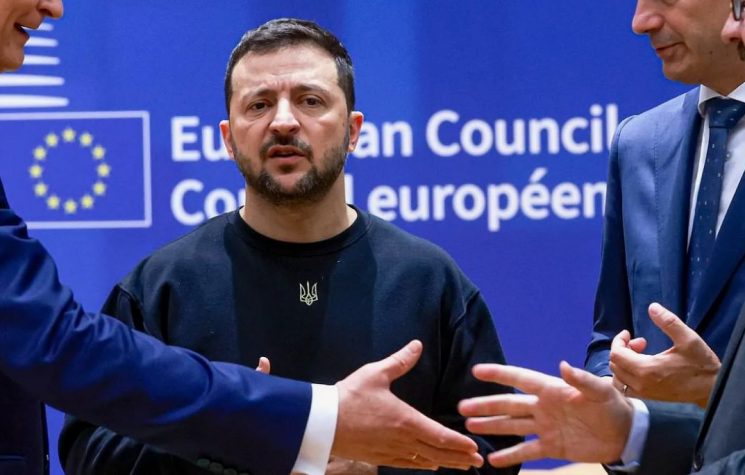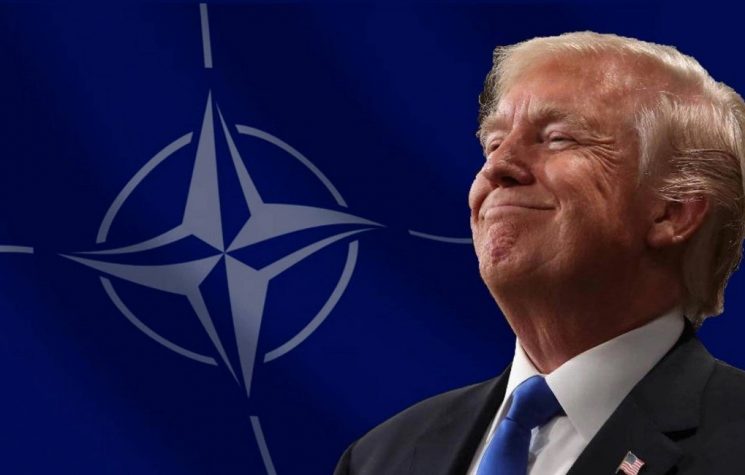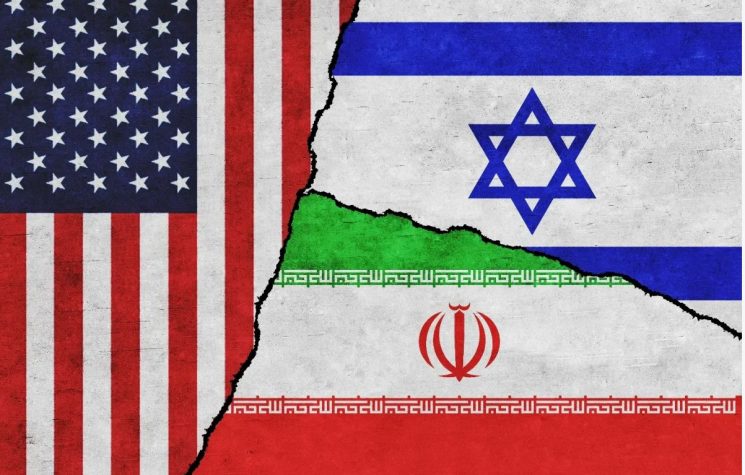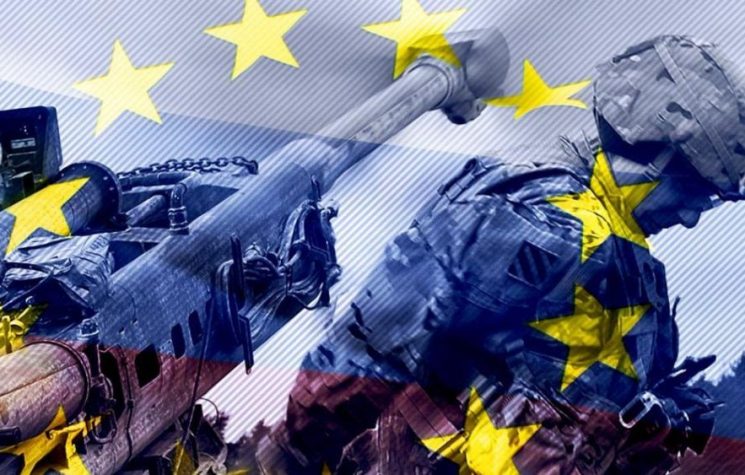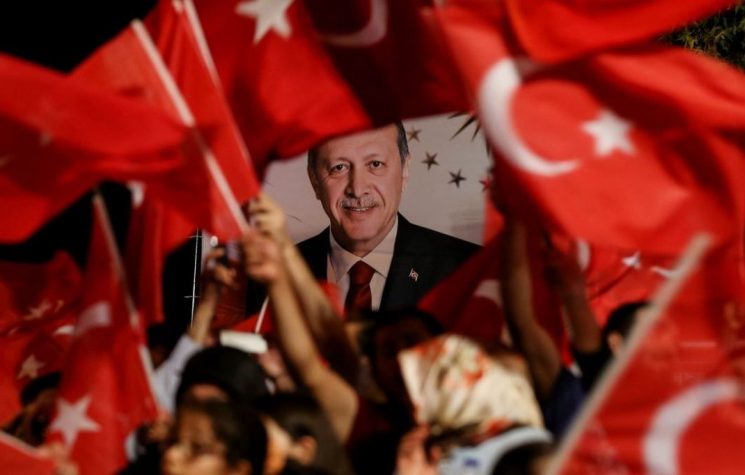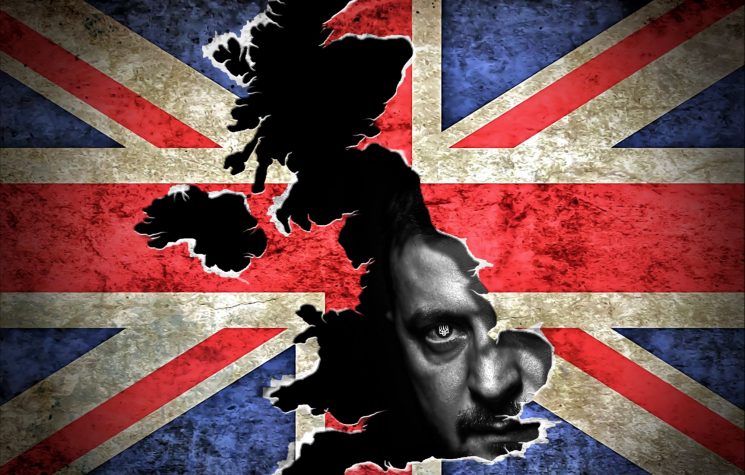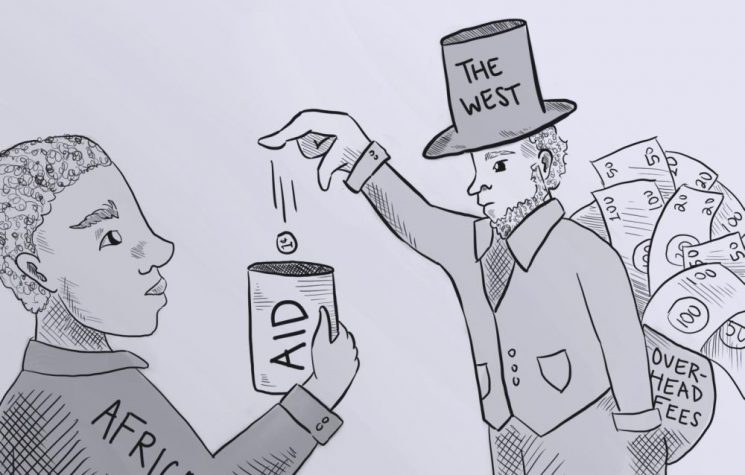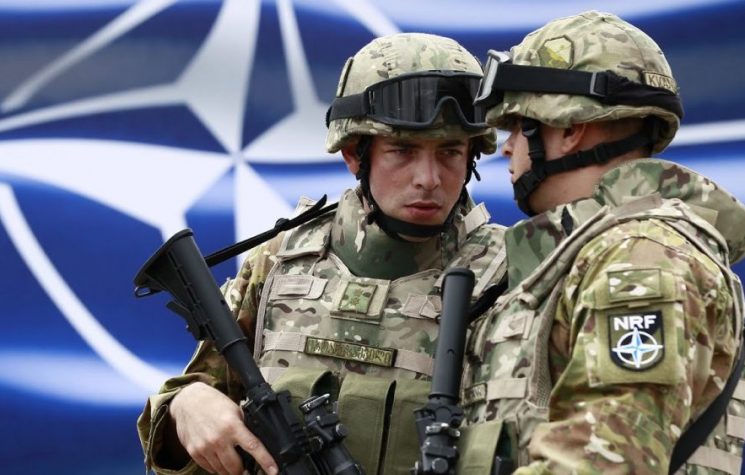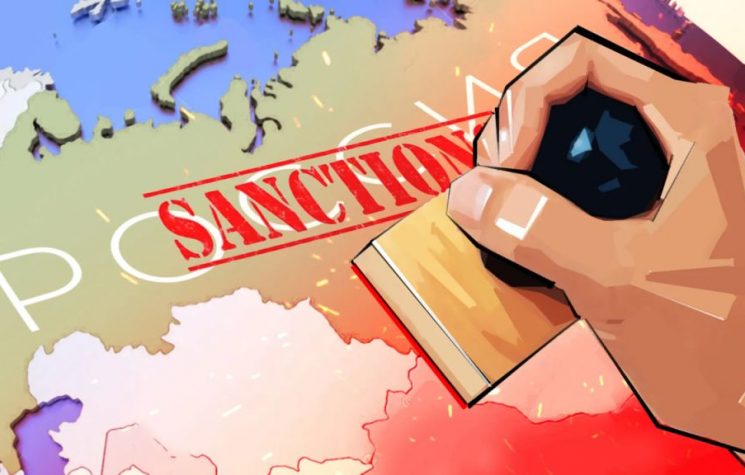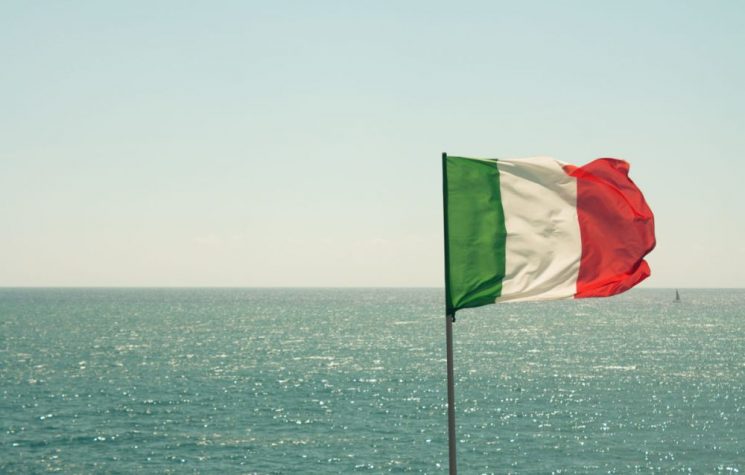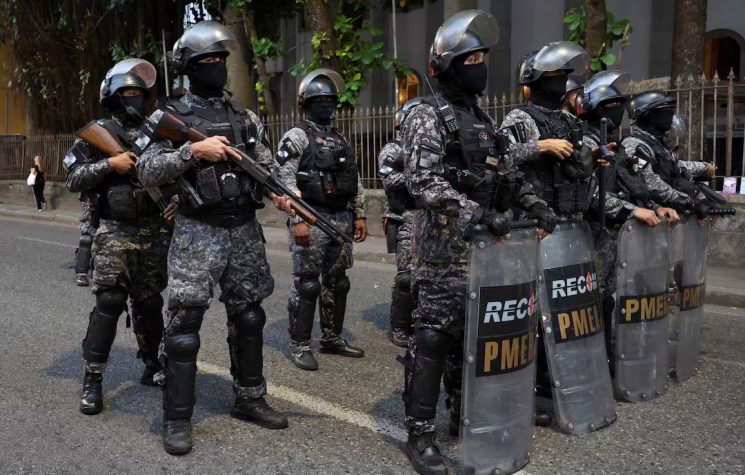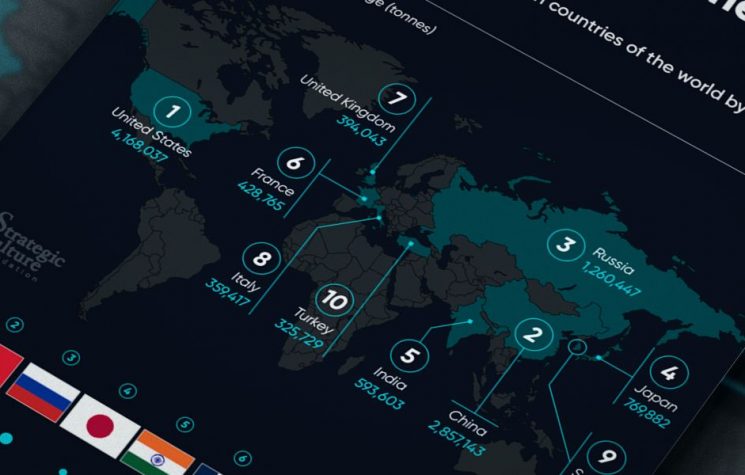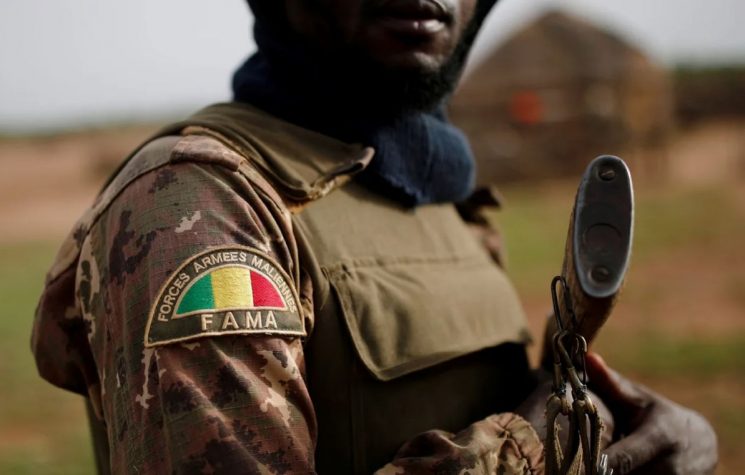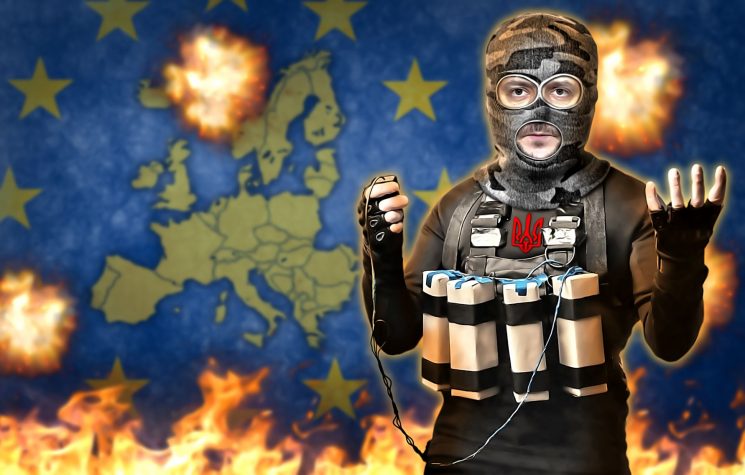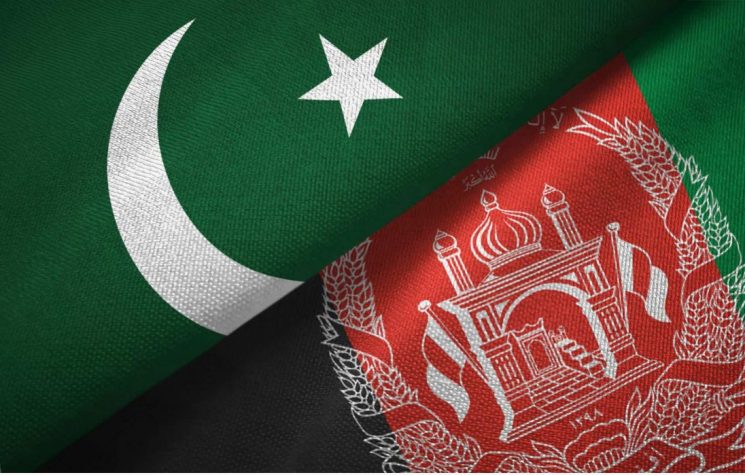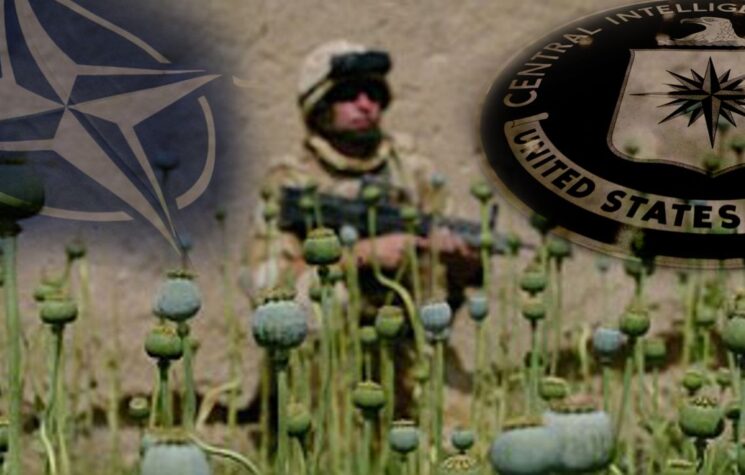Everyone is aware of the Iron Curtain speech delivered by Winston Churchill. However, it is not Churchill who is the originator of the phrase.
“You had to attack civilians, the people, women, children, unknown people far from any political game. The reason was quite simple – to force the people to turn to the state to ask for greater security.”
Vincenzo Vinciguerra, convicted Italian terrorist, former member of the Avanguardia Nazionale (“National Vanguard”) and Ordine Nuovo (“New Order”)
This is part 3 to a five-part series. [Refer here for Part 1 and Part 2, the latter which goes over how the Ukrainian Nationalist Movement Post WWII was Bought and Paid for by the CIA.]
Nazi Germany: The Bulwark of the West against Communism
“By destroying communism in his [Hitler’s] country, he had barred its road to Western Europe…Germany therefore could rightly be regarded as a bulwark of the West against communism.” (1)
– The Earl of Halifax, aka Lord Halifax (British Ambassador to the U.S. 1940-1946, Secretary of State for British Foreign Affairs 1938-1940, Viceroy and Governor-General of India 1926-1931)
Everyone is aware of the Iron Curtain speech delivered by Winston Churchill, who was no longer British Prime Minister by then, on March 5, 1946.
However, it is not Churchill who is the originator of the phrase, but rather Nazi German Foreign Minister Count Lutz Schwerin von Krosigk who made a speech in Berlin on May 3, 1945, which was reported in the London Times and the New York Times on May 8, 1945. In the speech, Krosigk uses the Nazi-coined propaganda phrase “Iron Curtain,” which was used in precisely the same context by Churchill less than one year later.
Following this German speech, only three days after the German surrender, Churchill wrote a letter to Truman, to express his concern about the future of Europe and to say that an “Iron Curtain” had come down. (2)
This sharing of policy between Nazi Germany and England should not come as a complete surprise.
The Molotov-Ribbentrop Pact signed August 23rd, 1939 is what has gone down in history in notoriety. However, an important fact is often left out, that this notorious pact was signed a full 11 months after UK Prime Minister Neville Chamberlain signed the appeasement deal with Hitler on September 30th, 1938 known as the Munich Agreement (aka the Munich Betrayal).
Historian Alex Krainer writes:
“The story we were taught in school was that the British government agreed to partition Czechoslovakia only as a desperate measure to avoid a greater European war. This view is based on the idea that Germany was already an overwhelming military power that could easily crush Czechoslovakia’s weak defenses. However, this idea is patently false.” [emphasis added]
Alex Krainer continues:
“Created in 1919, Czechoslovakia was the most prosperous, most democratic, most powerful and best administered of the states that emerged from the Habsburg Empire… the idea that the Germans had a military advantage and that Czech’s security was weak were both fabrications of a sustained propaganda campaign, which was orchestrated by the British media and government representatives to mislead the British and European public…
In terms of quality, armaments and fortifications, the Czech army was known to be the best in Europe and was superior to German army in every way except for air support. On September 3rd 1938 the British military attaché in Prague wrote a cable to London, stating: “There are no shortcomings in the Czech army, as far as I have been able to observe…”
In addition, Czech security was supported by strategic alliances with France and the Soviet Union both of whom were at that time very keen on holding Germany in check and both of whom were significantly superior to Germany in terms of military strength.” [emphasis added]
That is, Czechoslovakia did in fact capitulate without resistance, but this was not because her defenses were weak. Rather, it was because her government had been given false promises and was ultimately played in favour of Germany by the treacherous scheming of Britain’s secret diplomacy.
Lord Halifax, who was quoted earlier, was among the British negotiators of the Munich Agreement. For the rest of the story refer to Alex Krainer’s excellent paper here.
What in fact happened as a result of the Munich Agreement was that Hitler’s Germany acquired Czechoslovakia’s superior army and transformed Germany into a colossal threat that would be much more difficult to defeat.
In addition, the Bank of England and the Bank of International Settlements, through BoE Governor Montague Norman, allowed for the direct transfer of 5.6 million pounds worth of gold to Hitler that was owned by the Bank of Czechoslovakia.
Questionable actions from England indeed.
Germany had been allowed to become an ultra-supreme force through direct British intervention. It was only 11 months later that the Molotov-Ribbentrop Pact was signed as a means to forestall what was clearly the inevitable; a German attack on Russian soil, with the backing of Britain. [For more on this refer here.]
Operation Gladio: NATO’s Dagger
“The NATO axis of domestic terror hinged on the military-industrial complex controlled by the Pentagon, the cultivated revival of neofascism, and hired hands drawn from the Mafia criminal underworld.”
Richard Cottrell, “Gladio: NATO’s Dagger at the Heart of Europe”
With WWII won, the world was very much under the impression that we were to take the phrase “Never Again” to heart. Unfortunately, those in charge of forming western policy and geopolitical strategy post-WWII could not have disagreed more.
Operation Unthinkable is a prime example of the sort of thinking that was ruminating within Britain and the United States post-Roosevelt. Though the operation would be shelved with the new government under Clement Attlee, this remained a predominantly governing mindset for British and American intelligence and has remained so till this very day.
During WWII preparations were made in the case of a possible German victory and “stay-behind” guerilla warfare units were stationed throughout Europe. The model was the British Special Operations Executive, or SOE, a top-secret guerilla-commando force established in 1940. It was the brainchild of Winston Churchill and was called “Churchill’s secret army.” This would eventually be adopted into NATO. (3)

Above image: During the Second World War, the British Special Operations Executive carried out clandestine missions to support resistance organizations, inspiring the later Operation Gladio.
After the Allied victory, these “stay-behind” units were not disbanded but rather were strengthened and expanded in almost every European country, with direct aid and encouragement from the United States.
Member of the European Parliament (1979-1989), who was also tasked by the European Parliament with formal investigations, Richard Cottrell writes in “Gladio: NATO’s Dagger at the Heart of Europe”:
“After NATO was established in April 1949, the secret armies gradually came under the direct control of the new military alliance. NATO carefully established departments of clandestine warfare which managed the secret armies and allocated their tasks. Only a few trustworthy intimates were to know of their existence. As each secret unit was eventually exposed, the name Gladio came to be applied to all of them.”
However, the expected Soviet invasion never occurred. And thus, these secret armies found another purpose, they were to be used against the people.
The desire was that by staging false-flag operations that were blamed on communists, this would in turn invoke panic and revulsion and would send voters flocking to the welcoming arms of a secure Right-wing government.
Richard Cottrell writes:
“Bands of secret soldiers and their cohorts were ordered to shoot, bomb, maim and kill their own citizens. The United States forbade any sovereign European states to seat communist ministers in government. All movements of the Left fell under suspicion as cloaks for Moscow.”
Italy, who had the largest and most powerful communist party in Europe, would be first on the list.
The Communist Party of Italy, admired for leading the fight against Mussolini, was expected to win in Italy’s first post-war election in June 1946. This, of course, was considered intolerable under the Iron Curtain diktat.
Investigative journalist Christopher Simpson writes in his book “Blowback,” how a substantial part of the funding for the opposition to the Communist Party of Italy, which was the Christian Democratic Party, came from captured Nazi assets, (largely held by the Americans). This intervention tipped the balance in favour of Italy’s Christian Democratic Party, which hid thousands of fascists in its ranks.
The Christian Democratic Party would be the dominating party in Italy for five decades, during the Operation Gladio years, until it was dissolved in 1994.
In order to ensure that no further communist support were to arise in Italy, Operation Gladio, with knowledge and support by the CIA, MI6 and European intelligence agencies, led a campaign of brutal violence against Italians that stretched the better part of two decades known as the “years of lead,” the anni di piombo.
In 1959, an internal NATO briefing minute (dated June 1st, 1959) slipped into the hands of a British newspaper, revealing the task of the stay-behind units had been formally switched to confronting “internal subversion”. The secret armies were henceforth to play a “determining role…not only on the general policy level of warfare, but also on the politics of emergency.” (4)
What this meant was that a secret army of stay-behind units, under the direction of NATO, in absence of a Soviet threat, were to direct their actions to internal matters which would include espionage and acts of terrorism on the citizens of Europe with the support and cover of those nations’ police units. This would be used to further centralise control within Right-wing governments who supported the NATO apparatus.
Operation Gladio, which used the tactic Strategy of Tension, functioned on three basic levels. The first was a guerilla war to be fought primarily on the streets, in order to stiffen loyalties away from the Soviet Union.
The second level, was the political front and would involve NATO inspired conspiracies, such as claiming certain governments were in secret cahoots with the USSR, in order to evict democratically elected governments unfriendly to the NATO state apparatus and replace them with more pliable puppet regimes.
The third level was the assassination (hard and soft) of figures who were deemed obstructive to NATO’s aims. Examples of these include the assassination of Italy’s ex-Prime Minister Aldo Moro in 1978, Sweden’s Prime Minister Olof Palme in 1986 (known as Sweden’s JFK), Turkey’s Prime Minister Adnan Menderes in 1961 along with two cabinet colleagues, and U.S. President Kennedy in 1963. As well as the soft assassination (character assassination) of UK Prime Minister Harold Wilson. These assasinations would be followed by a NATO and U.S. support putsch.
Attempted assassinations from Operation Gladio include President de Gaulle (more on this shortly) and Pope John Paul II (for details refer to Richard Cottrell’s book).
The architect of Operation Gladio was Yves Guerin-Serac, a mastermind in black ops.
Yves Guerin-Serac: the Black Ops Grandmaster behind Operation Gladio
“He [Yves Guerin-Serac] was in thrall to his personal vision of a Christian-Fascist New World Order. He was also the intellectual mentor of Gladio terrorism. He wrote the basic training and propaganda manuals which can be fairly described as the Gladio order of battle.”
Richard Cottrell, “Gladio: NATO’s Dagger at the Heart to Europe”
Guerin-Serac was a war hero, Algerian rebel, agent provocateur, assassin, bomber, intelligence agent, Messianic Catholic, and intellectual grandmaster behind the Strategy of Tension/Operation Gladio.
Guerin-Serac published via Aginter Press the Gladio manual, including “Our Political Activity” in what can aptly be described as his First Commandment:
“Our belief is that the first phase of political activity ought to be to create the conditions favouring the installation of chaos in all of the regime’s structures…In our view the first move we should make is to destroy the structure of the democratic state under the cover of Communist and pro-Soviet activities…Moreover, we have people who have infiltrated these groups.” [emphasis added]
Guerin-Serac continues:
“Two forms of terrorism can provoke such a situation [breakdown of the state]: blind terrorism (committing massacres indiscriminately which cause a large number of victims), and selective terrorism (eliminate chosen persons)…
This destruction of the state must be carried out under the cover of ‘communist activities.’ After that, we must intervene at the heart of the military, the juridical power and the church, in order to influence popular opinion, suggest a solution, and clearly demonstrate the weakness of the present legal apparatus. Popular opinion must be polarized in such a way, that we are being presented as the only instrument capable of saving the nation.” [emphasis added]
Anarchic random violence was to be the solution to bring about such a state of instability thus allowing for a completely new system, a global authoritarian order.
Yves Guerin-Serac, who was an open fascist, would not be the first to use false-flag tactics that were blamed on communists and used to justify more stringent police and military control from the state.
On the 27th February 1933, Hermann Göring, Hitler’s second-in-command, shouted outside the burning of the Reichstag:
“This is the beginning of the Communist revolution! We must not wait a minute. We will show no mercy. Every Communist official must be shot, where he is found. Every Communist deputy must this very day be strung up!” (5)
It is quite incredible that western people seem to never get tired of this form of drama, no matter how many times they have heard it played.
The line of obvious patsies is also something that seems to never grow tiring. In the case of the Reichstag fire, now widely acknowledged as a false-flag, it was some befuddled Dutch Jew that was instantly accused.
The day after the fire, six days before the scheduled general election, Hitler persuaded the elderly and confused President von Hindenburg (the icon of WWI) that the crisis was of such profound gravity it could only be met by complete abolition of all personal liberties.
The “Reichstag Fire Law” conferred by Hindenburg gave Hitler many of the instruments that he required for a total seizure of power. Within two weeks, parliamentary democracy was also reduced to the smoking embers of history.
It would not be the only false-flag to be orchestrated by Hitler.
Cottrell writes:
“SS units forced a small group of concentration camp victims ‘released’ from Buchenwald and disguised in Polish uniforms, to stage a false flag mock attack on the main radio tower in the Nazi controlled free state of Danzig. Citing provocation by the Poles, the German invasion of Poland followed.”
Guerin-Serac spent his life in thrall to a new Black Empire which he dreamed would combine the universal divinity of the Roman church with the United States and Europe as successor to the Holy Roman Empire. This was Christian fascism.
He belonged to several old gangs, including the first generation of ex-Nazis and fascists. He also belonged to a veteran clan of French officers blooded in the Indo-Chinese and Korean struggles, and was member of the elite troop of the 11ème Demi-Brigade Parachutiste du Choc, which worked with the SDECE (French intelligence agency).
His connection to French Intelligence would be key in his becoming a founding member of the Organisation Armée Secrète (OAS), a French terrorist group, made up of disaffected French officers, based in Spain which fought against Algerian independence.
Guerin-Serac would form an intricate paramilitary and terrorist network throughout Europe, as well as training facilities to service Operation Gladio, via the cover of Aginter Press.
Richard Cottrell writes:
“Guerin-Serac arrived in Lisbon in 1966 with an inspirational blueprint for the next stage of the struggle against godless liberalism. He proposed…an organization that would act as nothing less than an international travel agency for terrorists. The principal funding was supplied by the CIA, according to the Pellegrino Commission established in 1995 by the Italian Senate to investigate the anni di piombo [years of lead]. Guido Salvini was the magistrate appointed to examine the 1969 bombing of the agricultural bank in Milan’s Piazza Fontana. He pinned the blame firmly on Guerin-Serac’s Aginter Press. Salvini told the senators that Aginter operatives were active in Italy from 1967 onwards, instructing local militant neo-fascist organisations in the use of explosives. From this nugget, the CIA is positively connected to the Gladio wave of terrorism sweeping Europe.”
Aginter Press, behind the plain business shopfront lay an invisible network designed to shuttle terrorists around Europe, Latin America, and Africa providing false documents and passports for killers posing as reporters and photographers including Guerin-Serac.
Cottrell continues:
“Aginter… was a Gladio finishing school, where recruits to the secret armies from all over Europe were trained in the arts of bomb making, assassination, psychological operations, destabilisation and counter-insurgency. Much of this was borrowed from the textbooks of the U.S. Army’s centre for covert warfare at Fort Bragg. Guest instructors from time to time included members of Britain’s SAS, the Green Berets and…French Army officers turn mercenaries…Guerin-Serac was blithely summoned to next door Spain to organise the death squads crushing resistance to the Franco regime. Aginter activities have been traced to all those countries where the Strategy of Tension operated at peak volume: Turkey, Greece, Cyprus, Italy, Germany and Belgium.”
De Gaulle vs. NATO
“France is determined to regain on her whole territory the full exercise of her sovereignty.”
– President of France Charles de Gaulle
After WWII there was increasing pressure for European nations to commit to the NATO diktat. President of France (1959-1969) Charles de Gaulle disagreed. One of the major points of this disagreement was over the force de frappe (nuclear striking force), which de Gaulle believed should be kept firmly outside of NATO’s control. He refused the prospect of France getting automatically dragged into a shooting war between NATO and the Warsaw Pact.
Cottrell writes:
“So deep were these frictions that France left the alliance integrated command structure in 1960, the first step on the road to resuming full military independence.”
De Gaulle’s relentless pursuit of French nationalism and independence in foreign and military policies was clearly incompatible with the North Atlantic charter.
When de Gaulle began talk of delivering Algeria her independence, it was decided by former allies, and members of his own military and police that de Gaulle had to go.
On April 21, 1961, a plot to overthrow President de Gaulle, organised by the OAS, swung into action.
Cottrell writes:
“On that day, four disaffected generals known as the ‘ultra group’ staged a coup in Algiers. The civil caucus in Washington, Pentagon and NATO headquarters in France were all implicated in the plot to eliminate the president and secure Algeria for the West. The coup leader, air force general Maurice Challe, was formerly commander of NATO’s forces in Central Europe.” [emphasis added]
Cottrell continues:
“Challe’s forces in Algeria were secretly primed with finance using channels closely connected to the French Gladio…On the eve of the coup, Richard Bissell, deputy head of the CIA’s covert operations wing, bore glad tidings to a secret pow-wow with Challe held in Algiers. Challe was told that if he could get the country under control inside 48 hours, then the U.S. government would formally recognise his regime…
The first outlines of the coup were agreed in the summer of 1960, when the former governor of Algeria, Jacques Soustelle, had a secret tete-a-tete with Bissell. In the same year, Challe stage-managed his resignation from NATO. In January 1961…the main plotters…assembled…the chief item on the agenda was to form the OAS as an alternative government, to follow de Gaulle once he had been toppled. Key figures in Plan Bleu were all present.” [emphasis added]
There would be over 30 assassination attempts on de Gaulle’s life during his presidency.
President de Gaulle was under no doubt that the real threat to his life came from the secret soldiers gathered under the umbrella of NATO.
According to Cottrell, it was Jacques Foccart, a chief advisor of de Gaulle, who informed him of the Permindex/World Trade Center (WTC) connection with OAS. Foccart had Permindex and WTC operations on Swiss soil shut down. [Part 4 will discuss the role of Permindex and WTC in greater detail.]
The NATO/CIA coalition had sponsored at least two attempts to eliminate de Gaulle. General Lyman Lemnitzer, Supreme Allied Commander of NATO (1963-1969) was among the key agitators.
In 1965 de Gaulle learned of yet another NATO-inspired conspiracy to have him shot. It would be the final straw. De Gaulle gave NATO headquarters immediate notice to quit altogether within 6 months. In addition, General Lemnitzer had received summary orders from de Gaulle to quit NATO. For the second time in his illustrious career, he would be fired (the first was by President Kennedy). [Further details in Part 4].
The withdrawal forced the relocation of NATO’s headquarters SHAPE (Supreme Headquarters Allied Powers Europe) from Rocquencourt, near Paris to Casteau, Belgium by October 16th, 1967.
After 43 years, in 2009 France would rejoin NATO, a decision made by President Nicolas Sarkozy. Cottrell adds that Sarkozy has had an interesting record of winning elections with dramatic perfectly timed post-terror interventions…
In the Quiet of a Small Town
“Sex trafficking, industrial paedophilia, the reports of snuff movies made for political and financial blackmail, or just for profit, were all entangled in a black cobweb of spies, officially connived drug running, the secret paramilitary network, and the constant meddling of NATO’s high command in the internal affairs of the country.”
Richard Cottrell, “Gladio: NATO’s Dagger at the Heart of Europe”
Belgium is made up of a Flemish and French ethnic population. During WWII, many Flemings either openly or symbolically sided with the Germans, in hopes of Flemish nationhood – even within a Nazi commonwealth – doing away with Belgium altogether.
Cottrell writes:
“A residue from wartime fraternisation with the Germans led to Nazi-style paganistic symbolism and mystical blood bonding ceremonies within the Belgian stay-behind network and elements of the national armed forces, which in any event inclined to the Right. This mystical streak was set for a chilling significance in shaping many of the perversion yet to be wrought on Belgium.” [emphasis added]
When the nascent EU institutions began searching for a home, they selected Brussels precisely because of its neutral, small country image as the “cockpit of Europe.” And that Belgium was wholly unequipped to deal with its foreign impostors and what would follow.
Cottrell writes :
“And what came next was NATO, evicted in insalubrious circumstances from France. The incoming warriors went about transforming this already schizophrenic state into the Kingdom of NATO. Hot on their heels came the rapid expansion of European federal institutions and the inward rush of huge corporations, eager to edge as close as possible to the councils of these two great caliphates, the most powerful military and economic alliances the world has seen since the Roman Empire.”
Little Belgium soon had the second most powerful and intrusive crime cartels in western Europe. In a very short time, Europe’s cockpit was also its chief narcotics and illegal arms hub, with a sideline of sex trafficking.
According to Cottrell, the CIA had recruited Belgian Nazis – mostly, but not exclusively, Flemish – as soon as the war ended, and selected them for high offices at state and provincial levels. Such “former” Belgian Nazi figures were protected from justice and released from prison under the protection of the CIA.
NATO’s machinations along with General Lemnitzer’s imported experts in counter-insurgency were responsible for the formation of the Belgian Gladio operations; divided scrupulously along politically correct lines into SDRA-8 (French) and STC/Mob (Flemish) divisions.
Cottrell writes:
“According to journalist Manuel Abramowitz – a leading investigator of the far Right in Belgium – neo-Nazis were egged on to infiltrate all the mechanisms of the state, with special attention reserved for the police and the army. By the 1980s, this level of penetration had become so deep – thanks to fascist fronts such as the neo-Nazi militia Westland New Post and its French speaking counterpart, Front de la Jeunesse – that Belgium’s military forces could be said to have fallen almost entirely under extremist control. Not once in the wake of the many false-flag operations over the coming decades, did convincing proof ever appear of a credible coordinated Left-wing subversive force operating on Belgian soil, while seditious organisations of the Far Right flourished openly.” [emphasis added]
Senator Hugo Coveliers chairman of the special investigating committee probing gangsterism and terrorism in Belgium (1988-1990) tracked the presence of incriminating materials to a special unit called the “judicial police.”
Here is what Coveliers said on what became known as the “scandal of the X-Dossiers”:
“Imagine, everywhere you hear that story about a blackmail dossier in which organisations of the extreme right are in the possession of pictures and videos on which a number of prominent people in and around Brussels have sex with young girls; minors it is said. The existence of this dossier has always been vehemently denied. Until it was proven that testimonies and videos of this affair indeed were in the possession of the police services.
The at first non-existing dossier turns out to exist. The videos without substance then turn out to be interesting enough after all to be handed over to the examining magistrate tasked with the investigation into the Gang of Nivelles [held responsible for some of the shop massacres]. But this person is subsequently afraid to testify about that! What do you think is going on here!” (6)
Cottrell explores these avenues in great detail in his book. He concludes that these sex-trafficking rings within Belgium, involving the abuse and murder of children, are encouraged among public officials for two reasons.
The first is to produce incriminating blackmail making political retreat impossible. The second possibility is that some of these activities that were recorded and retained in top secret files, were part of cultist initiation ceremonies.
Cottrell writes :
“It was alleged these involved paganistic neo-Nazi traits such as blood rituals, practised by elements within the state’s secret forces, as well as the orthodox military structure.”
In the context of this, NATO’s recent twitter scandal posting the Black Sun Nazi occult symbol this past international women’s day, might not have been a slip-up after all…

Italy’s Secret Parallel State
“We were a single body – bandits, police, and Mafia, like the Father, the Son, and the Holy Ghost.”
– testimony of Gaspare Pisciotta during the trial for the Portella della Ginestra massacre
In June 1981, an astonishing discovery was made that made the headlines worldwide, including with TIME magazine. A list had been found naming nearly 1,000 individuals from the respected Italian Establishment as part of a secret quasi-Masonic group, the Propaganda Due (P2) Lodge, “a state within a state.”
The P2 scandal provoked the fall of Prime Minister Forlani’s cabinet, who it was discovered had members in the P2 lodge.
The list was found on the premises of prominent Italian financier Licio Gelli during a police raid. Gelli being the grandmaster of the P2 lodge and prominent acolyte of Benito Mussolini. His sole aim was the restoration of Italian fascism.
Among the blacklist of nearly 1000, were the gentlemen (members of Propaganda Due) who were planning to seize power and install a fascist republic.
Descriptions of the Propaganda Due lodge in Italy were heavily overlaid with reports of mystical ceremonies, and the swearing of oaths of fealty and bonding vows.
Gelli fled to South America via Switzerland. Interestingly he was reportedly in Chile during Pinochet’s reign. Gelli would go through several trials, some in absentia, in Switzerland and Italy, charged with acts of terrorism among others crimes. [Refer here for more details.]
Another item Gelli left at his mansion when he fled was il piano di rinascita democratica, the Plan of Democratic Renewal, describing in detail every step of the intended NATO-backed Gladio putsch and the rise of the Italian deep state as an American and subsequently NATO protectorate. (7) The chief architect was Gelli himself.
It was through Gelli, that the CIA funded the Christian Democratic Party, which held numerous fascists within its membership.
Federico D’Amato was an Italian secret agent, who led the Office for Reserved Affairs of the Ministry of Interior (Italy) from the 1950s till the 1970s, when the activity of the intelligence service was undercover and not publicly known.
D’Amato became the head of the North Atlantic Treaty Special Office, a link between NATO and the United States. (8)
D’Amato’s chief responsibility was a secret Carabinieri (the national gendarmerie of Italy who primarily carry out domestic policing duties) nucleus located inside the Interior Ministry under his personal control. This was the Office of Reserved Affairs, also known as the Protective Service. (9)
Cottrell writes:
“This shadowy body [Protective Service] was a bedfellow with the OSS (later the CIA) in a well disguised bureau on Rome’s swish Via Sicilia.”
D’Amato was the handpicked delegate who negotiated the Atlantic Pact, a forerunner of NATO, on behalf of Italy. The Protective Service, under the control of D’Amato, was the early genesis of Gladio.
In 1969, Italy was soo gripped in a full-blown political crisis that was at its roots largely artificial. The huge blast in the Banca Nazionale dell’Agricoltura at Milan’s Piazza Fontana on Dec. 12 1969 marked the commencement of hostilities that came to be known as the years of lead. The blame was instantly pinned on the same Leftist radicals accused of provoking unrest in the Italian industrial heartlands.
Investigating magistrate Guido Salvina, began looking into the affair in 1988, and concluded that the bombing of the agricultural bank was an operation planned between Yves Guerin-Serac’s Aginter Press and two prominent Italian neo-fascist outfits Ordine Nuova (New Order) and Avanguardia Nazionale (Advance National Guard).
August 1990, Italian Prime Minister Guilio Andreotti (six times prime minister, a seventh would follow and leader of the Christian Democratic Party) found himself summoned to a special commission of inquiry hurriedly convened by the Senate to investigate the reports that a secret parallel state existed on Italian soil. And additionally, that this secret parallel state was equipped with its own clandestine commando army operating outside established military structures.
Andreotti conceded that for many years Italy indeed hosted a clandestine army. It was however formally an element of the standing NATO structure. He calmy assured his listeners it was nothing more threatening than a prudent precaution to defend Italy in the event of invasion by the Soviets. When the threat appeared to abate, Andreotti claimed that the secret soldiers were disbanded in 1971. Andreotti insisted, it was only a secret because the Russians were not supposed to know about the so-called “stay behind” army. He added, in any case Italy was not alone since all NATO countries had such forces.

Above image: August 1990, Italian premier Guilio Andreotti confesses to the existence of Operation Gladio at a special commission of inquiry
During his testimony, Andreotti admitted that this secret army was known as Gladio, which had well stocked arms dumps in every corner of the land. These munition dumps were supplied by NATO.
However, what Andreotti did not disclose during his testimony was that he was part of Gladio himself, a powerful shareholder in subterranean Italy for many years.
Andreotti was the one to replace assassinated Aldo Moro, mentioned earlier as one of the Gladio victims, as Prime Minister of Italy.
Vinciguerra, who was a member of the neo-fascist organization Ordine Nuovo and Avanguardia Nazionale, which carried out terrorist acts and assassinations is currently serving a life-sentence for the murder of three Carabinieri by a car bomb in Peteano in 1972. His testimonials aided in piecing together the Gladio networks around western Europe, that were being investigated by prosecutor Felice Casson.
In an interview with The Guardian, Vinciguerra discusses how he and his friends were sub-contractors to what he described as a:
“super-organisation which lacking a Soviet military invasion…took up the task, on NATO’s behalf, of preventing a slip to the Left in the political balance of the country [Italy]…”

And thus, when there is talk by such western counterparts who today claim “warnings” of false-flag operations from our supposed foes, I would suggest you take it with not a grain but rather a pound of salt.
[Part 4 will discuss the British and American, alongside NATO, involvement in Operation Gladio, and how the world drug and sex trafficking trade is tied into this via the United States. It will also discuss how this network was responsible for the murder of President Kennedy.]
The author can be reached at cynthiachung.substack.com.













